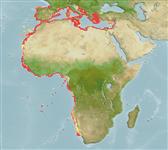Common names from other countries
Environment: milieu / climate zone / depth range / distribution range
Ekologi
; payau; kisaran kedalaman 76 - 496 m (Ref. 1695). Subtropical; 45°N - 30°S, 18°W - 36°E (Ref. 107067)
Eastern Atlantic and the Mediterranean: from Spain to Namibia.
Length at first maturity / Size / Weight / umur
Maturity: Lm ? range ? - ? cm Max length : 2.5 cm ML jantan/; (Ref. 104052)
Inhabits muddy bottoms; a sublittoral, demersal, or upper bathyal species found in depths between 76 and 496 m. Found in the brackish waters of the Sea of Marmara (salinity between 18 and 25 ppt). Species in the eastern and western Mediterranean (Aegean Sea) likely have an extended spawning period since mature animals are found throughout the year. May ascend to the surface during the spawning period and has been collected at the surface at night using artificial light. Caught throughout its range and consumed locally (Ref. 1695). Feeds mainly on crustaceans and fish (Ref. 107001).
Life cycle and mating behavior
Kematangan | Reproduksi, perkembang biakan | Pemijahan | telur-telur | Fecundity | Larva
Members of the class Cephalopoda are gonochoric. Male and female adults usually die shortly after spawning and brooding, respectively. Mating behavior: Males perform various displays to attract potential females for copulation. During copulation, male grasp the female and inserts the hectocotylus into the female's mantle cavity where fertilization usually occurs. Life cycle: Embryos hatch into planktonic stage and live for some time before they grow larger and take up a benthic existence as adults.
rujukan utama
Acuan | Koordinator | mitra
Jereb, P. and C.F.E. Roper (eds.). 2005. (Ref. 1695)
Status IUCN Red List (Ref. 130435)
status CITES (Ref. 108899)
Not Evaluated
Not Evaluated
penggunaan manusia
| FishSource |
Alat, peralatan
informasi lanjut
Umur / SaizPertumbuhanpanjang-beratpanjang-panjangMorfologiLarvaKelimpahan
Sumber internet
Estimates based on models
Preferred temperature
(Ref.
115969): 10.9 - 15.8, mean 14.1 (based on 159 cells).
keancaman
Low vulnerability (10 of 100).
kategori harga
Unknown.
